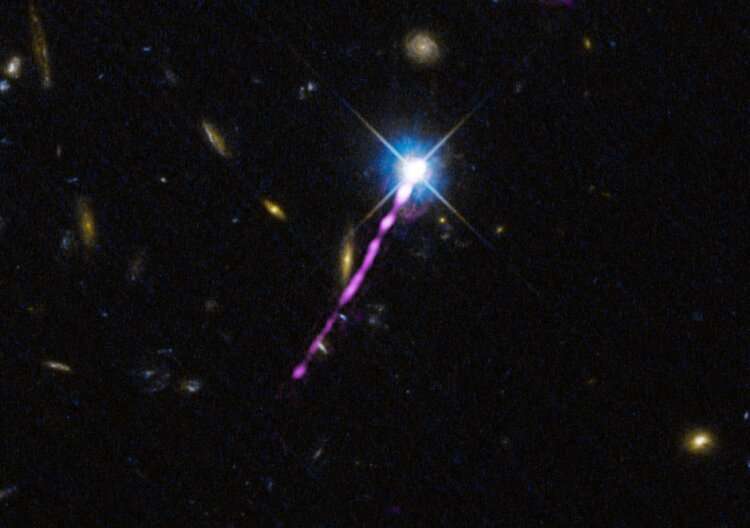Energy loss gives unexpected insights in evolution of quasar

An international team of astrophysicists observed for the first time that the jet of a quasar is less powerful on long radio wavelengths than earlier predicted. This discovery gives new insights in the evolution of quasar jets. They made this observation using the international Low Frequency Array (LOFAR) telescope, which produced high-resolution radio images of quasar 4C+19.44, located over 5 billion light-years from Earth.
Supermassive black holes many millions of times more massive than the sun reside in the central regions of galaxies. They grow even larger by attracting and consuming nearby gas and dust. If they consume material rapidly, the infalling matter shines brightly and the source is known as a quasar. Some of this infalling matter is not digested, but instead is ejected in the form of so-called jets that punch through the surrounding galaxy and into intergalactic space for millions of light years. These jets, shining brightly at radio wavelengths, are composed of particles accelerated up to nearly the speed of light, but exactly how these particles achieve energies not attainable on the Earth is yet to be completely solved.
The discovery on quasar 4C+19.44 gives new insights to the balance between the energy in the field surrounding the quasar and that residing in the quasar jet. This finding indicates the phenomenon arises from an intrinsic property of the source rather than absorption effects. It implies that the energy budget available to accelerate particles and the balance between energy stored in particles and in the magnetic field is less than expected.
"This is an important discovery that will be used for years to come to improve simulations of jets. We observed for the first time a new signature of particle acceleration in the power emitted by quasar jets at long radio wavelengths—an unexpected behaviour that changes our interpretation of their evolution," said Prof. Francesco Massaro from University of Turin. "This was already discovered in other cosmic sources, but it was never before observed in quasars."
The international team of astrophysicists observed the jet of the quasar 4C+19.44 at short radio wavelengths, in visible light, and X-ray wavelengths. The addition of the LOFAR images allowed astrophysicists to make this discovery. LOFAR is the first radio facility operating at long radio wavelengths, which produces sharp images with a resolution similar to that of the Hubble Space Telescope.
"We have been able to perform this experiment thanks to the highest resolution ever achieved at these long radio wavelengths, made possible by LOFAR." Said Dr. Adam Deller, an astrophysicist of the Swinburne University of Technology who contributed to the LOFAR data analysis and imaging of 4C +19.44 while at ASTRON in the Netherlands, heart of the LOFAR collaboration.
Dr. Raymond Oonk, an astronomer at ASTRON and Leiden University and Dr. Javier Moldon, astronomer at the University of Manchester, explained that "We have developed new calibration techniques for LOFAR and this has allowed us to separate compact radio structures in the quasar jet known as radio knots, and measure their emitted light. This result was unexpected, and demands deeper investigations. New insights and clues on particle acceleration will come soon, thanks to the international stations of LOFAR."
The observation performed on the radio jet of 4C+19.44 was designed by Dr. D. E. Harris, supervisor of Prof. Francesco Massaro, while working at the Harvard-Smithsonian Center for Astrophysics several years ago. He performed the observation in collaboration with Dr. Raffaella Morganti and his friends and colleagues at ASTRON. He only got the opportunity to see preliminary results, as he passed away on 6 December 2015. This publication, published in the first March issue of the Astrophysical Journal, is in memory of his career, which spanned much of the history of radio astronomy.
More information: D. E. Harris et al. LOFAR Observations of 4C+19.44: On the Discovery of Low-frequency Spectral Curvature in Relativistic Jet Knots, The Astrophysical Journal (2019). DOI: 10.3847/1538-4357/ab01ff
Journal information: Astrophysical Journal
Provided by ASTRON Netherlands Institute for Radio Astronomy




















